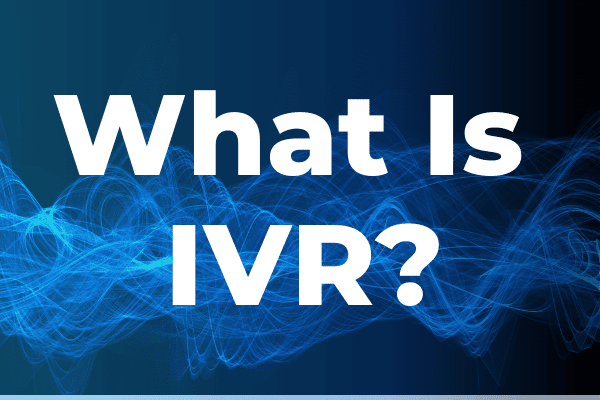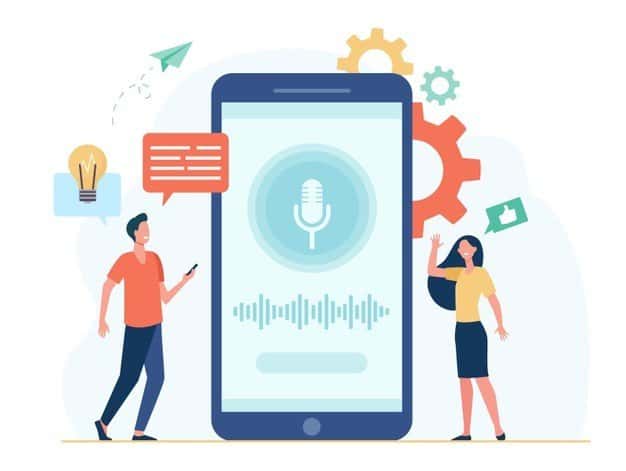What?
 While the name is relevant for this system, an IVR is regularly much more than an Interactive Voice System. It is more than a telephony menu that enables a dial pad or voice recognition system to guide a call to a given department.
While the name is relevant for this system, an IVR is regularly much more than an Interactive Voice System. It is more than a telephony menu that enables a dial pad or voice recognition system to guide a call to a given department.
IVR systems were launched in the 1980s and have remained popular throughout the last three decades. Back in the day, IVRs were used to receive incoming customer calls, process them according to a pre-recorded script and transfer the call to the agent on-site for subsequent dialogue or resolution. However, IVR systems have evolved from this simple switchboard model to a more advanced interactive feedback-oriented algorithm, offering a superior experience to the client and the agent alike.
At the basic level, it is an automated telephony system that interacts with the callers, gathers information, and directs the call to the appropriate recipient.
At a deeper level, it is much more because the functionality of this system is a simple and very effective way to reduce costs, improve customer experience, drive sales and reduce agent turnover rates. Adding an IVR to a high-volume contact center makes a world of a difference. This world includes lowering current volumes to increase capacity and take on a new high volume inbound customer (for a BPO for example) without increasing the number of agents. The system can also create the proper setting for a tailored customer experience (when using an Outbound IVR instead of a Predictive Dialer).
In other words, IVRs and how they interact have advanced dramatically since their inception, going from dual-tone multi-frequency (DTMF) entry points to voice recognition, using AI or even ML.
How?
While its static form is just an Interactive Voice Response that guides the caller through automated voice prompts, its dynamic form interacts not only with the caller but also with the CRM and Data Bases through routing mixes, automating customer service basic requests, call prioritization, and queuing, skill-based routing and much more.
Modern-day IVRs are part of both the cloud-based and premise-based contact center solutions; they can be created from scratch through scripts or interfaces, depending on their complexity; they can be embedded in the contact center solution or created based on a straightforward structure, customized to the strategy of the contact center.
Its structure is always the same, regardless of the way it is presented, and it consists of telephony equipment, software application, a database, and support infrastructure. Even when it is cloud-based or presented as a ‘drag and drop’ or ‘plug and play’ interface, the structure is not necessarily obsolete, only the components have shifted from physical to virtual.
Functionalities
Whenever you will bring up the IVR subject to a business owner or a contact center administrator, they will think about its inbound functionalities. While this covers most part of what an IVR does, it does leave out possible ways of using it for outbound campaigns. We will touch on this later on, as this can be used as an effective alternative to pre-recorded messages and predictive dialing.
Whenever a contact center administrator thinks about IVR, they might have more than Interactive Voice Response in mind. This is because the initial structure of the IVR was somewhat static, and it just directed customers to the right department. In time, with the addition of DNIS technology and skill-based routing, IVR has become an umbrella term for a dynamic self-service environment.
Static – can be used through DTMF alone
1. Customizable messages, pre-recorded messages, and prompts
2. Language selection
3. Gather customer information
4. Notify the customer about the call recording
5. Identify customer issue by asking probative questions or offering prompts with options
Dynamic – this is regularly accompanied by TTS, AI, or ML technology
A dynamic version of an IVR is an enhancement of the static one, being built on the same structure.
1. Self Service
The advances in AI technology have led to automated customer support, where technical issues, ordering, or complaints no longer require an agent to attend to them. In other words, if the issue is basic and does not require specialized knowledge, around 80% of customer support becomes self-service.
When it is not self-service, customer support also gets diversified to address the customer’s needs in a timely manner. Queue waiting times are lowered significantly, as customers can state their issue or request a call back without having to wait to talk to an agent. Similarly, an outbound IVR can be used for the call back initially, to verify the customer’s identity, check if the issue was solved, and then transfer the call to a live agent, if further assistance is needed. In other words, the remaining 20% of requests are simplified, they can be balanced between peak call times and non-peak, all at the customer’s choice.
This being said, we can conclude that call priority queuing ensures most issues are handled through self-service or transferred immediately to an agent. If an agent is not available, callbacks are created. When this is accompanied by DNIS technology and skill-based routing, an Outbound IVR can offer self-service for the issues not solved by the Inbound one.
2. Customized experience
In the voice mode of the IVR, the system uses speech recognition to acquire audio input from the user and utilizes speech synthesis (TTS – Text To Speech) or pre-recorded audio to respond to the user. The introduction of VoiceXML was the first revolution for IVRs. Back in the day, when only its static DTMF version was used, IVR technology was proprietary and IVR applications were cumbersome to build, thus limiting their utility. I will not get into the intricacies of how VoiceXML became a standard in the industry, but it is worth mentioning that it was the breakthrough that ensured speech environments can leverage widely available web-related technologies and associated skills, leading to the creation of a more powerful voice application. For more on the topic, open source VoiceXML and interpreters, it is discussed extensively here.
The introduction of TTS, ASR, and later AI in the IVR infrastructure has also changed the way customers perceive the agentless interaction with a service. They are no longer pushing buttons to get their message across or their complaint resolved, but talking to a system that knows their name, the regular issues they report, even their mother’s maiden name, if that’s what they set for a security question. This experience, especially for those that have interacted previously with a static IVR, will become more personal.
ML technology will definitely take this to a different level, with CRM integrations and database interactions. While we already have elaborate systems that do exactly that, I For more on the topic, open-source VoiceXML and interpreters, it is discussed extensively here. I will not get into details, since it is a digression from the IVR topic. Furthermore, when ML integrations will be popular for all IVR, we will likely encounter a totally different meaning for the environment created.
As described above, the artificial differentiation between static and dynamic can be based on primary functionality or logistics of the call versus advanced functionality or solving the request included in the call.
Most contact centers prefer dynamic IVRs, especially the high-volume ones. But you can encounter situations where even a static IVR can amplify a company’s image. For example, if a service is basically a one-man show or has 2 employees that wear many hats, scripting a static IVR can give the impression that the company is larger, that the call is transferred to different departments, and can turn a ‘mom and pop’ kind of business into a small enterprise, at least in the customer’s perception.
Benefits
External clients:
- Self-service
- Tailored customer experience
- Perceived availability
- Surveys to improve future interactions
Internal clients:
- Increased agent productivity
- Decrease agent turnover and burnout by improving FCR (first call resolution) rates
- More opportunities for training and specialization
Business benefits:
- Reduced call volumes
- Reduced operational costs overall, not only at the front end
- Drives revenue and sales by increasing CLV through customized experiences
What is the use of IVR in contact centers?
The above suffices to describe the potential use and effectiveness of an IVR in a contact center, so I will digress with a personal story. When I started in Customer Service 12 years ago, I was agnostic to the terminology and had no idea what the abbreviation stood for. It was all the rave back then, as most high volume Customer Service departments started to use it to decrease inbound volume and high turnover employee rates.
What I did notice in the first week of using an IVR was that we went from 180-200 inbound calls/day/agent to at most 50-60. Some of the remaining calls were from customers stating they were used to ordering with a live agent on the phone, as they did not necessarily trust an automated system. It does take adaptation from customers and agents alike, as no agent script can offer a good answer to this concern. Our regular take was that human errors are less likely to occur in an automated ordering system. They were eventually convinced by this and by the waiting time they were facing if they wanted to order with a live agent.
The other thing I noticed, as I was just a beginner, was that the remaining calls had all the odds of not becoming routine, of not being the same ordering or technical call, over and over, day in, day out. I actually got the chance to explore through customer issues what the service was like in real-time, what the infrastructure and the backbone were like things you do not really get to in basic training, and most likely never get to if you are handling only basic requests.
The NobelBiz IVR system
Our complete cloud contact center solution NobelBiz OMNI+ comes with complete built-in IVR capabilities designed to boost productivity, save time and increase the overall call center KPIs.
The potential of the IVR technology pushed its utility beyond what was initially thought possible. This is how we ended up with a complex system that can be applied to virtually any type of scenario.
- Call Tags and Variable Routing: Capture information in variables based on menu selected, web service calls or database queries for decisions in routing or self-service workflow.
- Integration to External Systems: Use other web services or secure ODBC connections to populate variables and trigger routing or self-service workflow. Variables are then accessible in your agent applications.
- IVR Script Linking: Create a library of reusable IVR subscripts that can be used by new IVR scripts. Improve productivity with flexible and consistent IVR scripts that are used as “building blocks” for customer service functionality.
- IVR Script Scheduling: Set schedules for when your IVR and self-service workflows are presented to the customer. Schedule different IVR scenarios based on time of day, call center operational hours, and after-hours requirements.
- IVR Scripting Designer: An intuitive drag-and-drop interface along with more advanced features, such as linking scripts together and using a single script for multiple inbound programs, allow you to easily build IVR functionality.
- Menus and Prompts: Add menu options and add your own audio files that represent the voice of your brand.
- In-Queue Announcements: Plays audio files in IVR scripts for callers in queue.
- IVR Scripting Designer: Create robust IVR scripts using a drag and drop IVR designer for the creation of routing rules and self-service applications.
Conclusion
Aside from the obvious, the IVR is one of the pillars of an efficient contact center.
It is not only a ‘nice to have, but a ‘must have’. It is embedded in most contact center solutions (including our own NobelBiz OMNI+ platform) by default, and I am certain most people find it odd when a service does not have an IVR. Though some might say it no longer falls into the digitally disruptive technologies, it was one at some point and can be developed further. I have Outbound IVRs in mind here, as prerecorded messages and autodialers have saturated the market and are limited by extensive regulations, at least in the US. These are effective when used informatively, but create a mediocre impression when used for Sales, Fundraising or Collection campaigns.
Using an AI IVR on Outbound to qualify a prospect will increase the likelihood of a Sale, while a voicemail or repeated calls might not. Once Outbound IVRs will become as popular as the Inbound ones, we will probably witness a revolution for Outbound calling, focused more on improving the customer journey than on volume.

Michael McGuire is a contact center industry expert with almost two decades of experience in the space. His experience includes roles as Director of Contact Center Digital Transformation at NobelBiz, and as Director of Operations at FLS Connect, managing multiple call centers. As President of Anomaly Squared and Targeted Metrics, Michael successfully transitioned companies into remote operations and significantly boosted revenues. With a strong background in customer service, leadership, strategic planning, and operations management, Michael excels in driving growth and innovation in the call center space.
Mike is also a proud Board Member for R.E.A.C.H Trade Group, promoting consumer protection and satisfaction and Co-host of the Off Skripted Podcast – a show about Life, Call Centers and everything in between.








